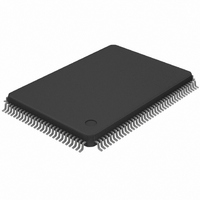DS21Q42T+ Maxim Integrated Products, DS21Q42T+ Datasheet - Page 53

DS21Q42T+
Manufacturer Part Number
DS21Q42T+
Description
IC FRAMER ENHANCED T1 4X 128TQFP
Manufacturer
Maxim Integrated Products
Datasheet
1.DS21Q42T.pdf
(116 pages)
Specifications of DS21Q42T+
Controller Type
T1 Framer
Interface
Parallel/Serial
Voltage - Supply
2.97 V ~ 3.63 V
Current - Supply
75mA
Operating Temperature
0°C ~ 70°C
Mounting Type
Surface Mount
Package / Case
128-TQFP, 128-VQFP
Lead Free Status / RoHS Status
Lead free / RoHS Compliant
DS21Q42
The other hardware based signaling operating mode called signaling re–insertion can be invoked by
setting the RSRE control bit high (CCR4.7=1). In this mode, the user will provide a multiframe sync at
the RSYNC pin and the signaling data will be re–aligned at the RSER output according to this applied
multiframe boundary. In this mode, the elastic store must be enabled however the backplane clock can be
either 1.544 MHz or 2.048 MHz.
If the signaling re–insertion mode is enabled, the user can control which channels have signaling re–
insertion performed on a channel–by–channel basis by setting the RPCSI control bit high (CCR4.6) and
then programming the RCHBLK output pin to go high in the channels in which the signaling re–insertion
should not occur. If the RPCSI bit is set low, then signaling re–insertion will occur in all channels when
the signaling re–insertion mode is enabled (RSRE=1). How to control the operation of the RCHBLK
output pin is covered in Section 12.
In both hardware based signaling operating modes, the user has the option to replace all of the extracted
robbed–bit signaling bit positions with ones. This option is enabled via the RFSA1 control bit (CCR4.5)
and it can be invoked on a per–channel basis by setting the RPCSI control bit (CCR4.6) high and then
programming RCHBLK appropriately just like the per–channel signaling re–insertion operates.
The signaling data in the four multiframe buffer will be frozen in a known good state upon either a loss of
synchronization (OOF event), carrier loss, or frame slip. This action meets the requirements of BellCore
TR– TSY–000170 for signaling freezing. To allow this freeze action to occur, the RFE control bit
(CCR4.4) should be set high. The user can force a freeze by setting the RFF control bit (CCR4.3) high.
The four multiframe buffer provides a three multiframe delay in the signaling bits provided at the RSIG
pin (and at the RSER pin if RSRE=1). When freezing is enabled (RFE=1), the signaling data will be held
in the last known good state until the corrupting error condition subsides. When the error condition
subsides, the signaling data will be held in the old state for at least an additional 9 ms (or 4.5 ms in D4
framing mode) before being allowed to be updated with new signaling data.
Transmit Side
Via the THSE control bit (CCR4.2), the framer can be set up to take the signaling data presented at the
TSIG pin and insert the signaling data into the PCM data stream that is being input at the TSER pin. The
user has the ability to control which channels are to have signaling data from the TSIG pin inserted into
them on a channel–by–channel basis by setting the TPCSI control bit (CCR4.1) high. When TPCSI is
enabled, channels in which the TCHBLK output has been programmed to be set high in, will not have
signaling data from the TSIG pin inserted into them. The hardware signaling insertion capabilities of the
framer are available whether the transmit side elastic store is enabled or disabled. If the elastic store is
enabled, the backplane clock (TSYSCLK) can be either 1.544 MHz or 2.048 MHz.
11.
PER-CHANNEL CODE (IDLE) GENERATION AND LOOPBACK
Each framer in the DS21Q42 can replace data on a channel–by–channel basis in both the transmit and
receive directions. The transmit direction is from the backplane to the T1 line and is covered in Section
11.1. The receive direction is from the T1 line to the backplane and is covered in Section 11.2.
11.1 Transmit Side Code Generation
In the transmit direction there are two methods by which channel data from the backplane can be
overwritten with data generated by the framer. The first method which is covered in Section 11.1.1 was a
feature contained in the original DS21Q41 while the second method which is covered in Section 11.1.2 is
a new feature of the DS21Q42.
53 of 116











